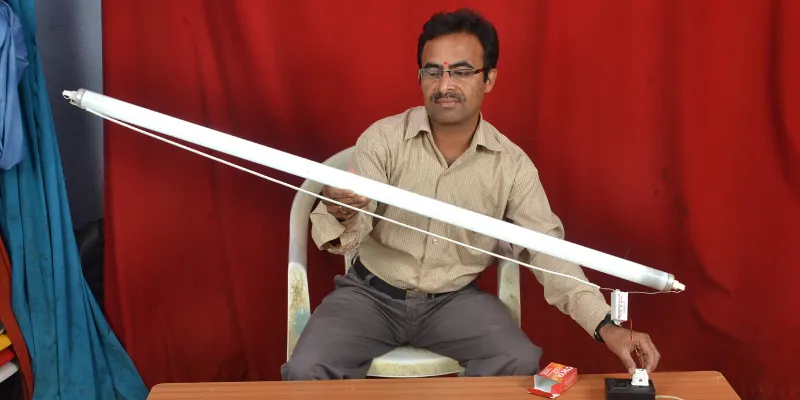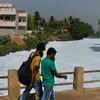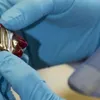This Telangana-based engineer is helping dead tube lights re-glow with his patented innovation
Thirty-nine-year-old Narsimha Chary has collaborated with various panchayats and civic bodies to successfully re-glow more than 10 lakh tube lights throughout India.
As a kid, Narsimha Chary spent more time with objects that were made up of plastic, silicon, and lithium, than with Koosh balls and Hot Wheels. While children in his neighbourhood were engaged in playing hopscotch and kho-kho, he was busy experimenting with motors and building electromagnetic toy trains in his uncle’s repair shop.
Today, Narsimha is 39-years-old and is in the process of brightening up the world by bringing dead tube lights back to life.

It took seven years for Narsimha Chary to accomplish his mission of re-lighting discarded tube lights.
It all started in the year 2000 when he invented an integrated circuit that could re-glow failed tube lights without using a choke and starter. However, Narsimha’s journey was not easy. It took him seven years of hard work and dedication to achieve the feat.
SocialStory met Narsimha during the Jagriti Yatra, who, while speaking about his endeavour said,
“I knew that my mission, if successful, could help electrify many areas that were lying in darkness across the country. Therefore, right from spending long hours in the library to conducting research and trials at home, I did not spare any effort.”
So far, Narsimha has collaborated with various panchayats, civic bodies, and municipal corporations to successfully re-glow more than 10 lakh tube lights throughout India. Further, he is continuing this endeavour of electrification by working with the National Institute of Rural Development (NIRD).
He won a slew of accolades for his invention, the most prominent one being - the ‘Great Minds, Long Miles – Quest for Answers’ award, as part of an initiative run by Siemens, to search for impactful innovations at the grass-root level. The 39-year-old was also featured on the Discovery Channel.
Initial journey
Narsimha was the youngest among four siblings, and was born and brought up in the Nizamabad district of Navipet, Telangana. Back in the day, his father owned a metal-cum-furniture works shop and had to toil day and night to make ends meet. Owing to his interest in the subject of science, he was always on a quest to explore, observe, and learn through trial and error.

Narsimha Chary after winning the 2019 'Sustainable Enterprise Award' from Coca Cola and Jagriti Yatra.
When Narsimha was in Class 3 at ZP Central Primary School, he designed a model to exhibit the Earth’s revolution around its axis using light-weight plastic balls. This won him an award at the district-level science fair. The boy’s tryst with tube lights began in 1991 when he stumbled upon a mound of defunct tube lights on the premises of the Navipet electricity board.
“I saw hundreds of tube lights just strewn all over the place. And my thoughts started hovering around how these can be reused. That day, I took it upon myself to find a way in which they can be lighted again. I was studying in Class 7 at Navipet’s Modern Public School then. Right after class, I used to go to the central library to read as much as possible about different electrical components. Unfortunately, Google did not exist at that time,” Narsimha adds.
For the next seven years, Narsimha’s world revolved around filaments, glass, and electrodes. He did a Bachelor’s degree in Electronics from an open university, so he could spend more time in research work.

Narsimha receiving the Intinta Innovator State Award from KT Rama Rao, Minister for IT and Industries, Telangana.
In 2000, after a series of experiments, he orchestrated a method to re-glow discarded tube lights by developing an integrated circuit. “It was the happiest day of my life,” he exclaims.
“Tube lights fail once their filaments open up. This is also when they lose their capacity to produce the required voltage to light up. So I made a circuit using resistors, capacitors, nichrome springs, among other components. This, in turn, is capable of moving the electron from cathode to anode, utilising the five-milligram unused mercury to produce electricity. The above process does not need any filament, induction coil, choke, or starter, and it soon came to be known as the ‘Chary Formula’,” Narsimha explains.
Narsimha’s work was first published by a Telugu magazine called Eenadu. Soon after, many other media organisations started featuring his invention. In the meanwhile, he got an offer from Vijay Rural Engineering College to join as a Professor, which he later accepted. The 39-year-old bagged many accolades under the ‘Best Project’ category over the years, as part of the State Youth Exhibition in 2004-05, General Electric Innovation Contest in 2007-08, etc.
Lighting up the lives of others
The aspect that differentiates Narsimha from others is his never-say-die attitude. Despite encountering many failures in his journey, he kept trying until he attained success. That is not all. He wanted his work to benefit the community around him.

39-year-old Narsimha Chary showing a demo.
Most of us tend to throw away tube lights and CFL bulbs once they stop functioning, without being aware of its detrimental effects. The mercury vapour in it can contaminate soil, water, and even the air we breathe. The Chary Formula tackles this by assisting people to re-glow their failed tube lights for at least three years, and also by clearing up all the mercury present in it. Besides, the cost of re-lighting the tube lights using Narsimha’s integrated circuit is as low as Rs 50, whereas purchasing new ones involves shelling out at least Rs 500.
“Every year, the government spends hundreds of thousands of crores on electricity. Yet, India has not achieved 100 percent electrification. My goal is to be of service when it comes to providing cost-effective power to people. As part of this, I took up projects in collaboration with the Nizamabad Municipal Corporation, as well as the District Panchayat Office, to electrify discarded tube lights and set them up for lighting streets across 1,000 villages. The government was able to save around Rs 12.5 lakh due, at the end of it,” Narsimha says.
Narsimha, who presently holds a patent for his invention, is working with the National Institute of Rural Development (NIRD) to electrify various other parts of the country, which are surviving in darkness without electricity.
When asked about his biggest learning in life, he said, “Curiosity and hard work can take you places.”
(Edited by Suman Singh)









